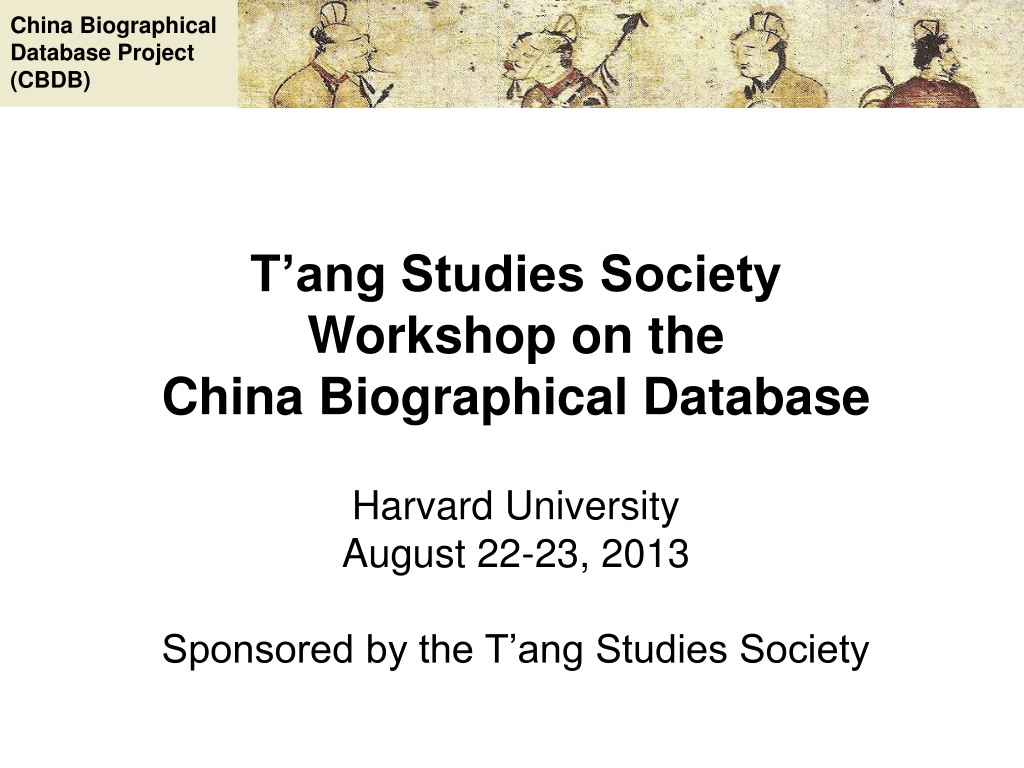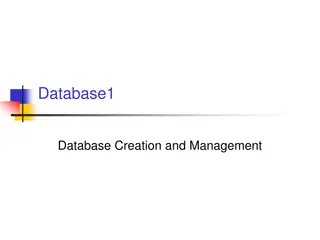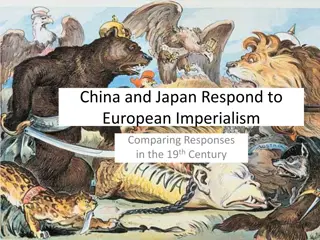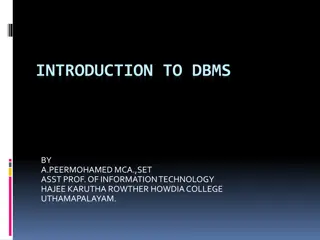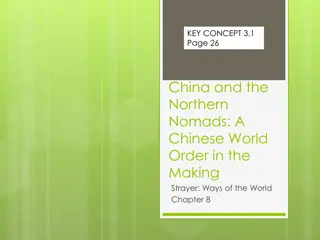China Biographical Database Project (CBDB) Workshop Highlights
Explore the insights shared at the Tang Studies Society workshop on the China Biographical Database Project at Harvard University in 2013. Learn about the structure, functions, and entities tracked in CBDB, and delve into the tables representing key data categories. Get ready to leverage this valuable resource for your projects as you navigate the intricacies of database design and entity structuring.
Download Presentation

Please find below an Image/Link to download the presentation.
The content on the website is provided AS IS for your information and personal use only. It may not be sold, licensed, or shared on other websites without obtaining consent from the author. Download presentation by click this link. If you encounter any issues during the download, it is possible that the publisher has removed the file from their server.
E N D
Presentation Transcript
China Biographical Database Project (CBDB) T ang Studies Society Workshop on the China Biographical Database Harvard University August 22-23, 2013 Sponsored by the T ang Studies Society
China Biographical Database Project (CBDB) Session Two: The Structure and Functions of the China Biographical Database, with Query Examples Michael A. Fuller
China Biographical Database Project (CBDB) Part One: Structuring Entities in CBDB This morning we talked about database design in general. In this session, we are going to look at CBDB in particular. CBDB tracks the following entities: People Places Offices Kinship Social Associations Social Distinctiveness Social Institutions Texts Ethnicity
China Biographical Database Project (CBDB) I am going to go over how CBDB represents these entities as tables in some detail for two key reasons: First, one of the central issues you will need to think about tomorrow is how to take advantage of the entities and the table in CBDB in your projects in your projects. Second, the details of how we designed the tables in CBDB (especially the problems of the limits and complexity of data) may be of some help as you think through the design of your own data. In order to think about how to create and structure entities, you will need some understanding of how CBDB has approached them.
China Biographical Database Project (CBDB) Please open CBDB on your computer and look for the following tables: Table BIOG_MAIN ADDR_CODES OFFICE_CODES KINSHIP_CODES ASSOC_CODES STATUS_CODES SOCIAL INSTITUTION_CODES TEXT_CODES ETHNICITY_TRIBE_CODES Entity People Places Offices Kinship Social Associations Social Distinctiveness Social Institutions Texts Ethnicity
China Biographical Database Project (CBDB) For those of you using Macs, we need a brief detour to set up the usage of the files. I hope everyone has installed: 1. OpenOffice Base 2. The Mac ODBC Administrator program 3. The ODBC driver for SQLite 4. The two versions of the CBDB SQLite databases CBDBCore.db 20130818CBDBao.db Now, go into Utilities in Finder and open ODBC Administrator
China Biographical Database Project (CBDB) Go to User DSN and Add CBDBFull as an SQLite DSN
China Biographical Database Project (CBDB) Next (and this is tedious), add the keyword database with the value of the full path and name of 20130818CBDBao.db
China Biographical Database Project (CBDB) Now launch OpenOffice Base: Choose the third option, Connect to an existing database Select CBDBFull. Save the odb file wherever you like. Base opens, by default with the Forms. Click on Tables.
China Biographical Database Project (CBDB) Table BIOG_MAIN Entity People (not all of them) the CBDB ID for the person Fields c_personid c_name c_name_chn c_index_year c_female c_ethnicity_code c_household_status_code c_birthyear c_by_nh_code c_by_nh_year c_by_range a year used in searches yes/no a code for the before/during/after
China Biographical Database Project (CBDB) Table BIOG_MAIN Entity People In BIOG_MAIN some fields are codes that refer to other tables. ZZZ_BIOG_MAIN, in contrast, fills in the values of these codes by using the information from the code tables. Repeating the text descriptions violates normalization, i.e., makes the table denormalized but easy for humans to use. For example: BIOG_MAIN c_ethnicity_code ZZZ_BIOG_MAIN c_ethnicity_code c_ethnicity_chn (from ETHNICITY_TRIBES_CODES) c_ethnicity_rmn (from ETHNICITY_TRIBES_CODES)
China Biographical Database Project (CBDB) Table BIOG_MAIN Denormalized Table ZZZ_BIOG_MAIN Entity People BIOG_MAIN also uses a strategy to represent uncertainty used throughout CBDB: sometimes texts give us broad information about dates, like . The data is useful, if this is all we have, and we record it using a combination of and range information: c_by_nh_code (375 = ) c_by_nh_year (NULL) c_by_range (0 = during )
China Biographical Database Project (CBDB) Entity People In addition to the data recorded in BIOG_MAIN, CBDB also records names, an additional type of data concerning People that is not related to other entities. Because one person may have many names, it requires a separate table: ALTNAME_DATA (supported by the codes of ALTNAME_CODES) And its denormalized version: ZZZ_ALTNAME_DATA
China Biographical Database Project (CBDB) Entity People How People become eligible for entry into Office is not exactly an entity, but it is important. One person also may qualify for office through various distinct means (yin privilege, the examination followed by the , etc.) Thus CBDB has a pair of tables to track entry into government: ENTRY_CODES ENTRY_DATA
China Biographical Database Project (CBDB) Entity People First, ENTRY_CODES (please open) As you can see, we have 239 modes of entering service. To simplify analytic inquiries, we have a pair of tables to aggregate these 239 modes: ENTRY_TYPES (17 types + 7 sub-types) ENTRY_CODE_TYPE_REL (maps codes to type/subtype) We are now going to build a query to allow us to see all the people in the Tang dynasty who entered via examinations.
China Biographical Database Project (CBDB) Open the Query Builder, select the tables, and create this: This general approach works for all the sets of tables
China Biographical Database Project (CBDB) Entity People Next, returning to ENTRY_DATA, note its complexity as a table (please right-click to open in Design View): Other people often played a role in people s entry into office, and CBDB tracks both kin roles (esp. for yin) and social associations. In later dynasties, specific institutions also played a role in entry into government service.
China Biographical Database Project (CBDB) Table ADDR_CODES Entity Places Places in CBDB are specifically administrative units, the official designations of places within the pre-modern bureaucratic system. The table ADDR_CODES (Please open) frankly needs work. The goal has been to create a system of codes that match those in the CHGIS (China Historical GIS) database. We generated our codes from Robert Hartwell s initial data to implement the rule: create a new code only when administrative unit boundaries change. His data on boundaries was less than perfect, and current codes still are more bound to dynasties than we want.
China Biographical Database Project (CBDB) Table ADDR_CODES Entity Places The fields in ADDR_CODES are: c_addr_id c_name c_name_chn c_first_year c_last_year c_admin_type x_coord y_coord CHGIS_PT_ID c_notes c_altnames the basic ID used in all other tables this is a TEXT field, to be replaced by an ID this is still (?) the coordinates of the centroid for the polygon this violates the one-to-many rule
China Biographical Database Project (CBDB) Table ADDR_CODES Entity Places Because Places are administrative units, CBDB needs to track their place within the hierarchy of units, to know what units are parts of a place and the unit to which it reports. This information is captured in ADDR_BELONGS_DATA. (Please open this table) Because this table is machine-friendly / user-unfriendly, CBDB also has a second table ADDRESSES that also shows the hierarchy. (Please open.) Each record gives an ascending list of units ending in a dynasty.
China Biographical Database Project (CBDB) Table ADDR_CODES Entity Places To simplify querying, I have created a third table: ZZZ_BELONGS_TO It lists all the units within a given place. That is, for a , it lists all the . For a or , it lists all the and , and so on.
China Biographical Database Project (CBDB) Table OFFICE_CODES Entity Offices Representing Office as an entity still needs work. There are three problems: 1.Very general titles given in texts. For example, some texts simply state , but we have 153 office titles with in them. How should we handle this? 2.Cross-dynastic analyses: at present our office codes are by dynasty. 3.Bureaucratic structure: to do good analytic studies of bureaucratic interactions, we need a good idea of who reports to whom. We have some detail for the Song dynasty and are working on the others. (It turns out that this sort of information is difficult to reconstruct.) Open the form frmPickOfficeTree (by double-clicking on it)
China Biographical Database Project (CBDB) Table OFFICE_CODES Entity Offices In any case, the core structure of OFFICE_CODES is: the main ID for offices the dynasty c_office_id c_dy c_office_pinyin c_office_chn c_office_trans No real surprises here. Since there are no foreign keys (codes that refer to other tables) except the dynasty, there is no denormalized equivalent.
China Biographical Database Project (CBDB) Table OFFICE_CODES Entity Offices However, two additional tables are needed to represent the information about bureaucratic structure that we need to know. These two tables are: OFFICE_TYPE_TREE OFFICE_CODE_TYPE_REL OFFICE_TYPE_TREE lists all the institutions that make up the pre-modern Chinese bureaucracy, and OFFICE_CODE_TYPE_REL links specific offices to the bureaucratic structure.
China Biographical Database Project (CBDB) Table KINSHIP_CODES Entity Kinship We have far too many kinship codes (please open the table to look at them): we will need to rationalize this in the future. The structure of KINSHIP_CODES is: c_kincode c_kinrel_chn c_kinrel the basic ID the Chinese term the English term c_kinpair_1 c_kinpair_2 the obverse relation for males the obverse relation for females c_upstep, c_dwnstep c_marstep, c_colstep kinship distance values (i.e. FB = 1 up, 1 collateral)
China Biographical Database Project (CBDB) Table ASSOC_CODES Entity Social Associations As with kinship codes, we have many, many association codes (again, open the table and take a look) and no doubt will have more as we collect more data. The structure of the ASSOC_CODES table itself is simple: c_assoc_code c_assoc_desc c_assoc_desc_chn the basic association ID c_assoc_pair c_assoc_pair2 the obverse relation the third code in triadic relations
China Biographical Database Project (CBDB) Table ASSOC_CODES Entity Social Associations However, because we have so many specific association codes, we need to be able to aggregate them for analytic purposes. For this, we use two additional tables: ASSOC_TYPES (please open) ASSOC_CODE_TYPE_REL The ASSOC_TYPES table provides categories and sub- categories under which to classify specific associations. The ASSOC_CODE_TYPE_REL table then links associations to larger categories Let s create a query to select a type of association for Tang.
China Biographical Database Project (CBDB) Table STATUS_CODES Entity Social Distinctiveness When we first began to develop CDBD, we started with Hartwell s categories, but as we looked at textual data, Hartwell s status evolved into a way of marking what people were known for in the lifetime and afterwards, hence social distinctiveness. The structure of STATUS_CODES is the simplest yet: c_status_code c_status_desc c_status_desc_chn
China Biographical Database Project (CBDB) Table STATUS_CODES Entity Social Distinctiveness Once again, we gradually accumulated many types of social distinctions (please open STATUS_CODES) and needed to develop larger analytic categories. For this we use: STATUS_TYPES (please open) STATUS_CODE_TYPE_REL (please open) These are works in progress.
China Biographical Database Project (CBDB) Table SOCIAL INSTITUTION_CODES Entity Social Institutions Social Institutions are a new entity in CBDB, based primarily on Yuan and Ming data. At present, there are three main types: Buddhist institutions, Daoist institutions, and academies. What should be considered a singular instance of a Social Institution proves a bit complex: it can change from a Buddhist temple to Daoist and back again and still be the same institution. It can change names and even move and yet be the same institution. Our data structures capture this.
China Biographical Database Project (CBDB) Table SOCIAL INSTITUTION_CODES Entity Social Institutions SOCIAL_INSTITUTION_CODES has the following structure: c_inst_code c_inst_name_code c_inst_type_code a unique ID a name ID c_inst_begin_year (etc.) c_inst_end_year (etc.) c_inst_last_known_year c_source c_pages c_notes
China Biographical Database Project (CBDB) Table SOCIAL INSTITUTION_CODES Entity Social Institutions To complete our information about social institutions, however, we need two additional tables following the rule about one-to-many relations because an institution may have more than one name and more than one address: SOCIAL_INSTITUTION_NAME_CODES SOCIAL_INSTITUTION_ADDR
China Biographical Database Project (CBDB) Table TEXT_CODES Entity Texts We are almost done with our survey of entities. The next to last is Texts. In order to avoid mission creep, CBDB does not list individual titles within literary collections, nor does it record full texts nor give hyperlinks to texts (although this probably will come).
China Biographical Database Project (CBDB) Table TEXT_CODES Entity Texts TEXT_CODES records core information about texts but does not list all extant editions, etc. (Please open in design mode.) c_textid c_title_chn c_title c_title_trans the basic text ID c_extant c_text_country c_text_dy (etc.) other information
China Biographical Database Project (CBDB) Table TEXT_CODES Entity Texts The author of a text is one way in which People interact with Texts, and we will discuss the tables that record how People interact with other entities in the part of the presentation.
China Biographical Database Project (CBDB) Table ETHNICITY_TRIBE_CODES Entity Ethnicity One can argue whether Ethnicity is an entity or just an attribute of People. I suspect that views change depending on the dynasty. It may well be an entity in the Yuan and Qing. In any case, please open the table. At present we have 467 designations, and this is not likely to grow much. The core structure is: c_ethnicity_code c_name c_name_chn c_group_code c_subgroup_code the ID for ethnicity the largest category (Uyghur, etc.)
China Biographical Database Project (CBDB) We now have seen the main ENTITIES in CBDB. However, the heart of the database is not these entities but their interactions with People. Table ADDR_CODES Interactions with People BIOG_ADDR_DATA POSTED_TO_ADDR_DATA POSTING_DATA POSTED_TO_OFFICE_DATA KIN_DATA ASSOC_DATA ENTRY_DATA STATUS_DATA BIOG_INST_DATA ENTRY_DATA TEXT_DATA BIOG_SOURCE_DATA (BIOG_MAIN) Entity Places Offices OFFICE_CODES Kinship Social Associations KINSHIP_CODES ASSOC_CODES Social Distinctiveness Social Institutions STATUS_CODES SOCIAL INSTITUTION_CODES Texts TEXT_CODES Ethnicity ETHNICITY_TRIBE_CODES
China Biographical Database Project (CBDB) Notes on Entities interacting with People 1. Because a single posting may include more than one office in more than one place, we divide postings data into three separate tables: POSTING_DATA POSTED_TO_OFFICE_DATA POSTED_TO_ADDR_DATA 2. Social associations can be complex, and the structure of ASSOC_DATA reflects this complexity. (Please open in Design View.)
China Biographical Database Project (CBDB) Notes on Entities interacting with People 3. Please open BIOG_ADDR_CODES. These are the types of place associations we track as present. 4. Please open TEXT_ROLE_CODES. These are the types of roles for people we track. (Note that a single text may have more than one author, recipient, etc., and hence needs the separate table TEXT_DATA.)
China Biographical Database Project (CBDB) Part Two: Entities in the Access Query Builder (Here we switch over to Access.)
